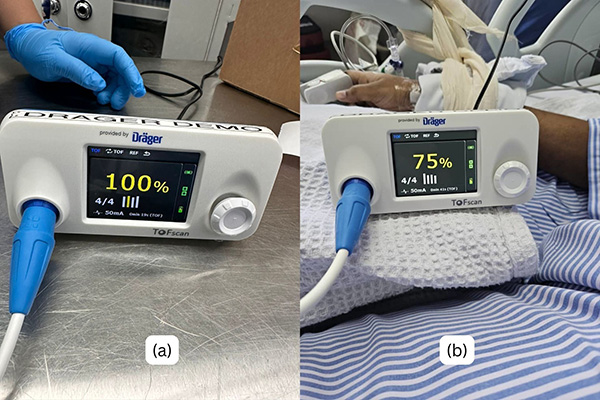Keywords
Abstract
We report a well-described but rare occurrence of suxamethonium apnoea, also known as Phase II block. A 16-year-old Burmese primigravida at 38 weeks and 4 days’ gestation was scheduled for an emergency lower segment Caesarean section due to poor progress in labour. Her antenatal course had been uneventful, and she had no significant medical history, allergies, or history of prior surgery. General anaesthesia was chosen due to her age and clinical circumstances. Rapid sequence induction was performed using intravenous propofol and suxamethonium. Muscle relaxation was subsequently maintained with atracurium. At the end of an uneventful surgery, reversal with neostigmine and atropine was administered upon observing spontaneous breathing effort. However, 30 minutes later, the patient still exhibited poor respiratory effort with persistent hypercapnia and poor motor strength. The patient was subsequently sedated with propofol and transferred to the Intensive Care Unit for ventilatory support and neuromuscular monitoring. She was extubated and transferred to the general ward the following morning.
References
Flood P, Rathmell JP, Shafer S. Stoelting’s Pharmacology and Physiology in Anesthetic Practice, 5e: Lippincott Williams & Wilkins; 2015.
Andersson ML, Møller AM, Wildgaard K. Butyrylcholinesterase deficiency and its clinical importance in anaesthesia: a systematic review. Anaesthesia. 2019;74(4):518-28. https://doi.org/10.1111/anae.14545
Robles A, Michael M, McCallum R. Pseudocholinesterase Deficiency: What the Proceduralist Needs to Know. Am J Med Sci. 2019;357(3):263-7. https://doi.org/10.1016/j.amjms.2018.11.002
Evans RT, Wroe JM. Plasma cholinesterase changes during pregnancy. Anaesthesia. 1980;35(7):651-4. https://doi.org/10.1111/j.1365-2044.1980.tb03878.x
Soliday FK, Conley YP, Henker R. Pseudocholinesterase deficiency: a comprehensive review of genetic, acquired, and drug influences. AANA J. 2010;78(4):313-20. PMID: 20879632
Rees JE. Suxamethonium apnoea. Update in Anaesthesia. 2005;19:41-42.
Viby-Mogensen J. Succinylcholine Neuromuscular Blockade in Subjects Heterozygous for Abnormal Plasma Cholinesterase. Anesthesiology. 1981;55(3):231-5. https://doi.org/10.1097/00000542-198109000-00008
Epstein HM, Jarzemsky D, Zuckerman L, Vagher P. Plasma cholinesterase activity in bank blood. Anesth Analg. 1980;59(3):211-4. PMID: 7189352
Geyer BC, Larrimore KE, Kilbourne J, Kannan L, Mor TS. Reversal of Succinylcholine Induced Apnea with an Organophosphate Scavenging Recombinant Butyrylcholinesterase. PLoS One. 2013;8(3):e59159. https://doi.org/10.1371/journal.pone.0059159
Saxena A, Luo C, Doctor BP. Developing procedures for the large-scale purification of human serum butyrylcholinesterase. Protein Expr Purif. 2008;61(2):191-6. https://doi.org/10.1016/j.pep.2008.05.021






